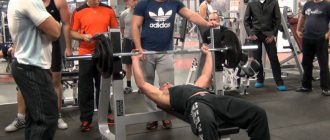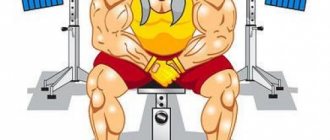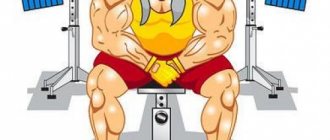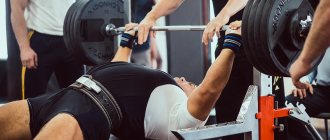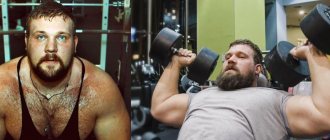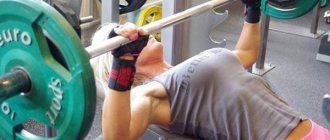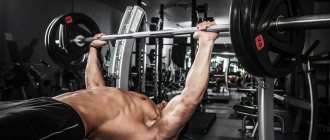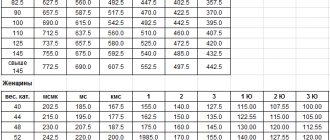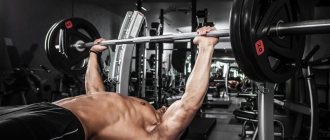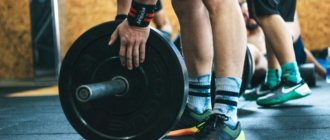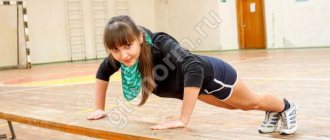Do you dream of reaching the level of master of sportsman or master of sports in the bench press? Do you want to know what category you can apply for now? Then you will need reference data on the standards in the barbell press . And we have already prepared them for you!
We warn you right away: there is no single figure here. Bench press standards can vary greatly and depend on:
- Powerlifting federations (AWPC, WPC, WRPF, WEPF, IPF, WDFPF, RDFPF, WUAP, AGPC, GPC, etc.)
- Weight category
- Gender (men and women)
- Presence or absence of doping control
- Use or non-use of equipment (no equipment, single-layer equipment, multi-layer equipment)
We tried to put together as many versions and options as possible.
Since the data is in the form of tables, it is advisable to view this page on a computer rather than on a phone, as tables may extend beyond the screen on mobile devices.
Also, regulations, even in the same federation, may be periodically reviewed and changed. Therefore, we provide this information as a guide only. If you seriously intend to pass the standard for any category or title, then be sure to check the relevance of this data on the official websites of the federations or with their representatives.
So, here we go:
Bench press standards - summary tables of various powerlifting federations with comments
Standards for the bench press without equipment, in single-layer (soft) and multi-layer equipment, are category standards adopted by one or another federation and fixed based on the results of official competitive events (tournaments) of the appropriate level. This means that bench press standards can only be met within the framework of competitions where representatives of one or another sports organization (federation) are present with the right to issue a rank book or certificate.
Bench press standards for masters and masters of masters can be met at regional competitions. Competitions awarding a rank up to MKMS usually have an All-Russian level, or are equivalent to it. The title of “Sports Elite” with a result corresponding to the bench press standards of a particular federation can only be obtained at international competitions (for example, the European Cup or the World Championship).
There are standards for bench presses without doping control and with passing a doping test. Of course, for objective reasons, doping standards are lower. Also, the standards for bench press without equipment are significantly lower than the standards for equipment divisions (after all, even a single-layer T-shirt adds an average of 50-80 kilograms to an athlete’s natural bench press).
However, a key point that beginner athletes often do not take into account is that different powerlifting federations have different standards for the bench press and other exercises. The difficulty here is that in order to fulfill the rank standards within the framework of an event held by a particular federation, you need to be a member of it (sometimes membership is paid). At the same time, some federations prohibit their members from performing at events of other federations (usually violation of this rule leads to the deprivation of all sports titles). All these points must be clarified with the regional representative of the organization before participating in the competition.
How much can you increase in bench press in a year?
Many athletes, when they first start working out in the gym, usually progress very quickly in their strength. This is where a certain illusion arises that they will progress like this constantly.
Adding 40-50 kg per year in the same bench press. But, as a rule, this is just an illusion...
Because as soon as you reach a certain weight, all your results will immediately stop. And then it will take you several years to overcome them.
You'll hit what's called a plateau, where no matter what you do, you can't add even a damn pound to your bench press.
I went through all this myself and got stuck first at 80 kg in the bench press, then at 100 kg. Then already at 110 kg, but then I made a very quick jerk and was able to reach first 140 kg, and then up to 175 kg.
Moreover, I achieved these results without taking pharmacology or any other drugs. Therefore, I know what a “plateau” is and I know how to deal with it...
But it took me about 7 years to go from 80 kg to 175 kg. So you don’t need to think that you will bench press 200 kg in a year. This is completely misleading...
We recommend reading: Which protein is best for gaining muscle mass and burning fat
On average, you will gain 15-20 kg in your bench press per year. This is despite the fact that you train purely without pharmacology and other drugs.
Once upon a time, when I was just starting to work out in the gym, one guy worked out with me. He was already benching more than 2 times his weight. Weighing 72 kg, he bench pressed more than 150 kg.
My bench press then was something like 80 kg. And when I asked him if I could bench press the same 150 kg just like him in a year. He said that if I exercise naturally, then I will not be able to bench press these same 150 kg even after 2-3 years.
And you know, he was right!
Because it took me more than 5 years to go from 80 kg to 150 kg in the bench press. And this path was long and difficult...
I have never taken pharmaceuticals in my life because I never had a goal to perform. Therefore, unlike many with whom I worked then, I was always interested in natural training methods.
Yes, it is more difficult and longer, but it is much more interesting.
Calculate your ideal sports weight!
Because having a natural base and knowing how to progress naturally, you will be able to progress very quickly also on pharmacology.
While everyone was progressing at the speed of a cheetah, I was progressing at the speed of a turtle. But many of them remained benching 140-150 kg, and I moved on and after a couple of years I first overcome 175 kg, and then 185 kg.
Yes, this path was not close, but now I clearly know and understand how to plan my training in order to constantly progress.
Therefore, if you think that every year you will add 40-50 kg to your bench press, then this knowledge of yours is erroneous and incorrect.
Because in the best case, if you plan your training correctly, then by the end of the year you will get +15 +20 kg to your already maximum weights, and sometimes even less...
But, after all, many will not wait that long and will most likely resort to taking steroids. Well, it’s up to you, I just said what result and in what time you can get it.
The bench press exercise is used by athletes to develop (mainly) the muscles of the arms, back and chest. Performed with free weight. Its essence is that the athlete removes the barbell from a specially made riser with his arms completely straight, then bends his arms until the bar touches his chest, and then must again straighten his arms completely with the weight. The exercise is considered completed when the entire cycle is completed without errors. As a rule, such exercises are performed by weightlifters who are professionally involved in bodybuilding or powerlifting.
Depending on the weight, the method of lifting it, and the number of actions performed, different muscle groups develop. This is important if the bench press is practiced by bodybuilders, for whom the whole essence of training comes down to the harmonious development of muscle mass.
Of course, knowledge of the technique alone is not enough to flawlessly fulfill the standard. Very often, young and energetic athletes remain out of work due to the fact that they simply do not adhere to certain rules by which such strength exercises should be performed. In this case, even if the athlete is actually able to lift the weight assigned to him, even a slight deviation from the stipulated procedure may cost him a failure.
Therefore, in addition to the basic technique, it is worth paying attention to the following points:
- the judge should always be located at the head of the athlete in order to fully view the process of performing the exercise;
- the athlete must lie completely on a special bench, the buttocks of his body are prohibited from being torn off the bench while lifting weights, his legs must be in full contact with the floor surface at all times, his head is positioned according to the athlete’s convenience;
- in order to get normal support for the legs, and this is very important due to the different heights of athletes, it is allowed to use blocks or discs as a basis. With their help, a small graveyard is performed so that the legs of the person squeezing the barbell completely touch the support when the exercise is performed;
- to support (insure) the athlete during the procedure of squeezing the barbell, the presence of up to 4 insurers is allowed (their responsibilities include assistance when it is necessary to remove the barbell from the racks, insurance during the bench press itself, returning the barbell to its original fixed and safe position after completing the necessary manipulations with the weight , at the same time, assistants should not block the view of what is happening to the judge recording the execution of the exercise);
- the maximum arm spread distance on the bar should be within 81 cm, for this there are special notches, the initial grip is discussed with the judge, and should also ensure the safety of the athlete during the bench press (especially important when lifting a large weight);
- after the start of the procedure for power lifting the barbell, when the projectile is given to the athlete with outstretched arms, he must lower the weight to his chest and lift it back at the command of the judge, who records the achieved result;
- as a rule, the signal should be given by the judge as soon as the bar reaches the chest and is fixed there in a stationary position, usually the voice command “press” is given;
- Only one signal is given to start the action. If you don’t have time to get your bearings, the exercise will not be counted;
- the exercise is considered completed when, after the “press” command, the athlete completely squeezes all the weight previously lowered onto the chest onto the outstretched forelimbs.
The exercise must be performed under the supervision of a judge with the opportunity to review all the nuances of the actions performed. To do this, assistants must be located on both sides of the ends of the bar in order to enable the referee to fully perform his duties.
IPF Bench Press Standards
In the Russian Federation, the international organization IPF (International Powerlifting Federation) is represented by the FPR (Russian Powerlifting Federation). This organization is state-owned, participation in its competitions is always absolutely free. However, the IPF standards are considered the most serious and difficult to implement; they are significantly higher than the standards of other federations. Please note: the IPF/FPR assigns ranks and titles only in powerlifting, but not in its individual elements.
In other words, there are no standards for the IPF bench press, because this federation holds competitions only in powerlifting (bench press, squat, deadlift) and there are only general standards for the sum of results in three disciplines. However, at all tournaments, competition between participants is carried out within each discipline. That is, an athlete can, at his own discretion, perform only one exercise and take a prize in a specific discipline, but in this case he cannot count on being awarded a sports category or title.
A little about the most common mistakes
Now a little about why the exercise may not be counted, and the athlete will simply waste his efforts and the time of the panel of judges. Among the most common mistakes are the following:
- the athlete ignores the judge’s commands or is in a hurry in the process of executing such commands;
- violation of the athlete’s position before starting the bench press, in particular, lifting the buttocks off the bench, incorrect positioning of the legs, incorrect (asymmetrical) positioning of the hands on the bar is a gross violation, due to which the exercise is considered not completed;
- if the barbell is knocked away from the chest while trying to lift it;
- when, having received the judge’s signal to perform an upward press, the athlete’s barbell begins to sag further down, pressing against his chest;
- in the case when, during a bench press, the arms begin to straighten unevenly upward (first one, then the other);
- if between the signals given by the judge (from the moment the press begins until the final signal is given to stop and fix the exercise performed), the assistants even accidentally touch the bar;
- when the athlete even accidentally lifts his legs off the floor and touches the bench supports with his feet;
- in the case when, during a bench press, an athlete even accidentally touches the support posts with the barbell in order to reduce the load when performing the exercise;
- violation by the assistant referee of the requirements to immediately leave the observation deck during the exercise.
WPC and AWPC Bench Press Standards
In the Russian Federation, the WPC (World Powerlifting Congress) is represented by the Russian Powerlifting Organization (OPR), which is also the official representative of a number of alternative federations, including GPC, WPF, WPA and WPU.
Please note: the standards for the WPC bench press are the same, there is no division with or without doping control. That is, doping tests are not carried out at such competitions at all. However, there is a division into divisions without equipment, in single-layer and in multi-layer equipment, the standards for them are different. At the same time, in all federations there is a division in the norms for men and women. Of course, bench press standards for women are always lower, regardless of the presence or absence of a doping test.
Below are the ranking standards that apply to all tournaments held by the OPR as of 2022.
Russian bench press records
Russian bench press is a fairly young sport; the first competitions in it took place less than 20 years ago. But this makes it no less interesting and spectacular. He already has his own records, which modern athletes strive to break.
Achievements of female athletes
The following results are relevant for spring 2022:
Table: records among girls under 15 years old
| Bar weight | Number of repetitions | Last name of the athlete |
| 25 kg | 97 | Mozharovskaya D.P. |
| 35 kg | 91 | Kostina I.S. |
| 45 kg | 35 | Dluzhnevskaya V.S. |
| 55 kg | 35 | Dluzhnevskaya V.S. |
Table: records among girls under 18 years old inclusive
| Bar weight | Number of repetitions | Last name of the sportswoman |
| 35 kg | 107 | Doskhoeva M.B. |
| 45 kg | 35 | Dluzhnevskaya V.S. |
| 55 kg | 35 | Dluzhnevskaya V.S. |
Table: records among women
| Bar weight | Number of repetitions | Last name of the athlete |
| 35 kg | 125 | Zoshchik M.V. |
| 45 kg | 83 | Murashova N.E. |
| 55 kg | 52 | Zoshchik M.V. |
| 65 kg | 23 | Zaugolova Yu.V. |
| 75 kg | 23 | Zaugolova Yu.V. |
Achievements of male athletes
The following results are relevant for spring 2022:
Table: records among boys under 13 years old
| Bar weight | Number of repetitions | Athlete's last name |
| 25 kg | 123 | Shilin D.N. |
| 35 kg | 58 | Novikov I.V. |
| 45 kg | 35 | Novikov I.V. |
| 55 kg | 10 | Novikov I.V. |
Table: records among boys under 15 years old
| Bar weight | Number of repetitions | Athlete's last name |
| 35 kg | 155 | Osipov V.S. |
| 45 kg | 84 | Tsvetkov A.A. |
| 55 kg | 81 | Abakshin M.S. |
| 75 kg | 42 | Kudaev A.A. |
| 100 kg | 20 | Kudaev A.A. |
| 125 kg | 8 | Kudaev A.A. |
Table: records among boys under 18 years of age
| Bar weight | Number of repetitions | Athlete's last name |
| 45 kg | 134 | Efremenko S.N. |
| 55 kg | 125 | Andreev E.I. |
| 75 kg | 59 | Epikhin I.P. |
| 100 kg | 33 | Terekhov M.N. |
| 125 kg | 13 | Kudaev A.A. |
| 150 kg | 10 | Serbin A.A. |
Table: records among men
| Bar weight | Number of repetitions | Athlete's last name |
| 55 kg | 191 | Pleshivtsev S.M. |
| 75 kg | 117 | Galtsov A.V. |
| 100 kg | 90 | Galtsov A.V. |
| 125 kg | 62 | Galtsov A.V. |
| 150 kg | 41 | Galtsov A.V. |
| 175 kg | 22 | Galtsov A.V. |
| 200 kg | 11 | Larionov O.P. |
Unequipped WPC Bench Press Standards
Men
| Weight category | Elite | MSMK | MS | KMS | I | II | III | I junior | II junior |
| 52 | 150 | 130 | 112.5 | 97.5 | 87.5 | 77.5 | 67.5 | 55 | 45 |
| 56 | 162.5 | 140 | 122.5 | 105 | 95 | 85 | 72.5 | 60 | 47.5 |
| 60 | 175 | 150 | 130 | 115 | 102.5 | 92.5 | 77.5 | 65 | 52.5 |
| 67.5 | 195 | 167.5 | 147.5 | 127.5 | 115 | 102.5 | 87.5 | 72.5 | 57.5 |
| 75 | 212.5 | 182.5 | 160 | 140 | 125 | 112.5 | 95 | 80 | 65 |
| 82.5 | 227.5 | 197.5 | 170 | 147.5 | 132.5 | 120 | 102.5 | 85 | 67.5 |
| 90 | 240 | 207.5 | 180 | 157.5 | 140 | 125 | 107.5 | 90 | 72.5 |
| 100 | 252.5 | 220 | 190 | 165 | 147.5 | 132.5 | 115 | 95 | 75 |
| 110 | 265 | 227.5 | 197.5 | 172.5 | 155 | 140 | 120 | 100 | 80 |
| 125 | 275 | 240 | 207.5 | 180 | 162.5 | 145 | 125 | 105 | 82.5 |
| 140 | 285 | 247.5 | 215 | 187.5 | 167.5 | 150 | 130 | 107.5 | 85 |
| 140+ | 292.5 | 252.5 | 220 | 192.5 | 172.5 | 155 | 132.5 | 110 | 87.5 |
Women
| Weight category | Elite | MSMK | MS | KMS | I | II | III | I junior | II junior |
| 44 | 75 | 65 | 55 | 47.5 | 42.5 | 40 | 35 | 27.5 | 22.5 |
| 48 | 82.5 | 70 | 62.5 | 55 | 47.5 | 42.5 | 37.5 | 30 | 25 |
| 52 | 90 | 77.5 | 67.5 | 60 | 52.5 | 47.5 | 40 | 35 | 27.5 |
| 56 | 97.5 | 85 | 72.5 | 65 | 57.5 | 52.5 | 45 | 37.5 | 30 |
| 60 | 105 | 90 | 77.5 | 67.5 | 62.5 | 55 | 47.5 | 40 | 32.5 |
| 67.5 | 117.5 | 100 | 87.5 | 75 | 67.5 | 60 | 52.5 | 42.5 | 35 |
| 75 | 125 | 110 | 95 | 82.5 | 75 | 67.5 | 57.5 | 47.5 | 37.5 |
| 82.5 | 135 | 115 | 100 | 87.5 | 77.5 | 70 | 60 | 50 | 40 |
| 90 | 140 | 122.5 | 105 | 92.5 | 82.5 | 75 | 62.5 | 52.5 | 42.5 |
| 90+ | 145 | 125 | 110 | 95 | 85 | 75 | 65 | 55 | 45 |
WDFPF/RDFPF (Russia)
— A doping-free federation. For the use of dope - lifelong disqualification.
Class standards WDFPF-RDFPF bench press
click on the picture to enlarge
Rank standards WDFPF-RDFPF bench press veterans
click on the picture to enlarge
Single Layer WPC Bench Press Guidelines
Men
| Weight category | Elite | MSMK | MS | KMS | I | II | III | I junior | II junior |
| 52 | 157.5 | 137.5 | 120 | 102.5 | 92.5 | 82.5 | 72.5 | 60 | 47.5 |
| 56 | 172.5 | 150 | 130 | 112.5 | 102.5 | 90 | 77.5 | 65 | 52.5 |
| 60 | 187.5 | 162.5 | 142.5 | 122.5 | 110 | 100 | 85 | 70 | 57.5 |
| 67.5 | 210 | 180 | 157.5 | 137.5 | 122.5 | 110 | 95 | 77.5 | 62.5 |
| 75 | 232.5 | 200 | 175 | 152.5 | 137.5 | 122.5 | 105 | 87.5 | 70 |
| 82.5 | 252.5 | 220 | 190 | 165 | 147.5 | 132.5 | 115 | 95 | 77.5 |
| 90 | 272.5 | 235 | 205 | 177.5 | 160 | 142.5 | 122.5 | 102.5 | 82.5 |
| 100 | 292.5 | 252.5 | 220 | 192.5 | 172.5 | 155 | 132.5 | 110 | 87.5 |
| 110 | 310 | 267.5 | 232.5 | 202.5 | 182.5 | 162.5 | 140 | 117.5 | 92.5 |
| 125 | 330 | 285 | 247.5 | 215 | 192.5 | 172.5 | 147.5 | 125 | 100 |
| 140 | 345 | 297.5 | 260 | 225 | 202.5 | 180 | 155 | 130 | 102.5 |
| 140+ | 355 | 307.5 | 267.5 | 232.5 | 210 | 187.5 | 160 | 135 | 107.5 |
Women
| Weight category | Elite | MSMK | MS | KMS | I | II | III | I junior | II junior |
| 44 | 80 | 70 | 60 | 52.5 | 47.5 | 42.5 | 37.5 | 30 | 25 |
| 48 | 90 | 77.5 | 67.5 | 60 | 52.5 | 47.5 | 40 | 35 | 27.5 |
| 52 | 100 | 85 | 75 | 65 | 57.5 | 52.5 | 45 | 37.5 | 30 |
| 56 | 107.5 | 92.5 | 80 | 70 | 62.5 | 57.5 | 47.5 | 40 | 32.5 |
| 60 | 115 | 100 | 87.5 | 75 | 67.5 | 60 | 52.5 | 42.5 | 35 |
| 67.5 | 130 | 112.5 | 97.5 | 85 | 75 | 67.5 | 57.5 | 47.5 | 40 |
| 75 | 140 | 122.5 | 105 | 92.5 | 82.5 | 75 | 62.5 | 52.5 | 42.5 |
| 82.5 | 150 | 130 | 112.5 | 97.5 | 87.5 | 80 | 67.5 | 57.5 | 45 |
| 90 | 160 | 137.5 | 120 | 105 | 92.5 | 82.5 | 72.5 | 60 | 47.5 |
| 90+ | 162.5 | 142.5 | 122.5 | 107.5 | 95 | 85 | 75 | 62.5 | 50 |
WPC bench press standards in multi-layer equipment
Men
| Weight category | Elite | MSMK | MS | KMS | I | II | III | I junior | II junior |
| 52 | 165 | 142.5 | 125 | 107.5 | 97.5 | 87.5 | 75 | 62.5 | 50 |
| 56 | 180 | 155 | 135 | 117.5 | 105 | 95 | 82.5 | 67.5 | 55 |
| 60 | 195 | 170 | 147.5 | 127.5 | 115 | 102.5 | 87.5 | 72.5 | 60 |
| 67.5 | 225 | 192.5 | 167.5 | 147.5 | 132.5 | 117.5 | 100 | 85 | 67.5 |
| 75 | 250 | 215 | 187.5 | 162.5 | 145 | 130 | 112.5 | 92.5 | 75 |
| 82.5 | 272.5 | 235 | 205 | 177.5 | 160 | 142.5 | 122.5 | 102.5 | 82.5 |
| 90 | 292.5 | 252.5 | 220 | 190 | 170 | 152.5 | 132.5 | 110 | 87.5 |
| 100 | 312.5 | 270 | 235 | 205 | 185 | 165 | 142.5 | 117.5 | 95 |
| 110 | 332.5 | 287.5 | 250 | 217.5 | 195 | 175 | 150 | 125 | 100 |
| 125 | 352.5 | 305 | 265 | 230 | 207.5 | 185 | 160 | 132.5 | 105 |
| 140 | 370 | 320 | 277.5 | 242.5 | 217.5 | 195 | 167.5 | 137.5 | 110 |
| 140+ | 382.5 | 330 | 287.5 | 250 | 222.5 | 200 | 172.5 | 142.5 | 115 |
Women
| Weight category | Elite | MSMK | MS | KMS | I | II | III | I junior | II junior |
| 44 | 87.5 | 77.5 | 67.5 | 57.5 | 52.5 | 47.5 | 40 | 32.5 | 27.5 |
| 48 | 97.5 | 85 | 75 | 65 | 57.5 | 52.5 | 45 | 37.5 | 30 |
| 52 | 107.5 | 95 | 82.5 | 70 | 62.5 | 57.5 | 50 | 40 | 32.5 |
| 56 | 117.5 | 102.5 | 87.5 | 77.5 | 70 | 62.5 | 52.5 | 45 | 35 |
| 60 | 127.5 | 110 | 95 | 82.5 | 75 | 67.5 | 57.5 | 47.5 | 37.5 |
| 67.5 | 142.5 | 122.5 | 107.5 | 92.5 | 82.5 | 75 | 65 | 52.5 | 42.5 |
| 75 | 155 | 132.5 | 115 | 100 | 90 | 82.5 | 70 | 57.5 | 47.5 |
| 82.5 | 165 | 142.5 | 125 | 107.5 | 97.5 | 87.5 | 75 | 62.5 | 50 |
| 90 | 175 | 150 | 130 | 115 | 102.5 | 92.5 | 77.5 | 65 | 52.5 |
| 90+ | 180 | 155 | 135 | 117.5 | 105 | 95 | 80 | 67.5 | 55 |
The given standards for living lying down WPC have been in effect since 2012 to the present day. There are no plans to change these standards and correspond to the category standards of international organizations, the representative of which on the territory of Russia is OPR.
The AWPC Federation (Amateur World Powerlifting Congress) is a structural division of the WPC (the prefix “amateur” indicates the amateur level of the competition). Their representative in Russia is also OPR. The peculiarity of the competitions of this organization is that the AWPC bench press standards are lower than the WPC standards (the same applies to other exercises). In addition, all participants in tournaments held under AWPC standards may be subject to mandatory doping testing.
The test is forced on 10% of participants, who are selected impartially by a committee of judges. Important note: if an athlete has fulfilled the standard for Master of Sports or higher, but has not been subject to forced testing, in order to receive the title he must pass the test and pay in full (at the moment (January 2017) this is 7,500 rubles). Otherwise, his result is recorded, according to the result he can take a prize place, but he does not receive a title until he passes a doping test. Failure of the test results in lifetime disqualification.
A little about the technique of performing this exercise
To avoid various injuries, as well as to obtain the desired effect in a short period of time, you must adhere to a certain technique for performing the exercise. In this case, the following nuances should be taken into account:
- the bench on which the athlete will lie must be strong, hard, stable and located at an angle of 0 to 30 degrees towards the athlete’s head;
- the bar with the required weight is installed on special racks or limiters;
- the athlete must lie on the bench so that his eyes are located directly under the bar;
- to obtain greater stability, you need to spread your legs wide and rest your feet on the floor (your shins should be perpendicular to the floor);
- if the bench is flat, the back is arched to its natural length; in the case of an inclined plane of the bench, the body is pressed tightly against the bench;
- when gripping the bar, the shoulders should be perpendicular to the floor, the grip can be wide or narrow, the exercise is usually performed with an assistant;
- if the bench press is horizontal, the bar should fall slightly below the nipples, with an inclined press, between the nipples and collarbone;
- after completing the bench press exercise, the barbell returns to the racks (this exercise must be performed with an assistant, or in his presence).
Remember, bench press exercises with a large weight must be performed with the presence of at least one assistant, so that if it is impossible to lift the weight to the starting position, someone can help you with this.
If it is not possible to attract such an assistant, familiarize yourself with the technique of how to perform an emergency termination of the exercise (in this case, the weights are not fixed, the barbell is carefully lowered onto the chest, and then its position is slightly changed so that the weights on one side have the opportunity to jump off, and then the weight is removed in the same way from the other side of the barbell. Ultimately, one bar should remain in the athlete’s hands).
AWPC Unequipped Bench Press Standards
Men
| Weight category | Elite | MSMK | MS | KMS | I | II | III | I junior | II junior |
| 52 | 127.5 | 110 | 95 | 82.5 | 75 | 67.5 | 57.5 | 47.5 | 37.5 |
| 56 | 137.5 | 120 | 102.5 | 90 | 80 | 72.5 | 62.5 | 52.5 | 42.5 |
| 60 | 147.5 | 127.5 | 112.5 | 97.5 | 87.5 | 77.5 | 67.5 | 55 | 45 |
| 67.5 | 165 | 142.5 | 125 | 107.5 | 97.5 | 87.5 | 75 | 62.5 | 50 |
| 75 | 180 | 155 | 135 | 117.5 | 105 | 95 | 82.5 | 67.5 | 55 |
| 82.5 | 192.5 | 167.5 | 145 | 127.5 | 112.5 | 102.5 | 87.5 | 72.5 | 57.5 |
| 90 | 202.5 | 175 | 152.5 | 132.5 | 120 | 107.5 | 92.5 | 77.5 | 60 |
| 100 | 215 | 185 | 162.5 | 140 | 125 | 112.5 | 97.5 | 80 | 65 |
| 110 | 225 | 195 | 167.5 | 147.5 | 132.5 | 117.5 | 100 | 85 | 67.5 |
| 125 | 235 | 202.5 | 177.5 | 152.5 | 137.5 | 122.5 | 105 | 87.5 | 70 |
| 140 | 242.5 | 210 | 182.5 | 157.5 | 142.5 | 127.5 | 110 | 90 | 72.5 |
| 140+ | 250 | 215 | 187.5 | 162.5 | 145 | 130 | 112.5 | 92.5 | 75 |
Women
| Weight category | Elite | MSMK | MS | KMS | I | II | III | I junior | II junior |
| 44 | 62.5 | 55 | 47.5 | 40 | 37.5 | 32.5 | 27.5 | 22.5 | 20 |
| 48 | 70 | 60 | 52.5 | 45 | 40 | 37.5 | 32.5 | 27.5 | 22.5 |
| 52 | 77.5 | 67.5 | 57.5 | 50 | 45 | 40 | 35 | 30 | 25 |
| 56 | 82.5 | 72.5 | 62.5 | 55 | 47.5 | 42.5 | 37.5 | 32.5 | 27.5 |
| 60 | 90 | 77.5 | 67.5 | 57.5 | 52.5 | 47.5 | 40 | 35 | 30 |
| 67.5 | 100 | 85 | 75 | 65 | 57.5 | 52.5 | 45 | 37.5 | 32.5 |
| 75 | 107.5 | 92.5 | 80 | 70 | 62.5 | 57.5 | 47.5 | 40 | 35 |
| 82.5 | 115 | 97.5 | 85 | 75 | 67.5 | 60 | 52.5 | 42.5 | 37.5 |
| 90 | 120 | 102.5 | 90 | 77.5 | 70 | 62.5 | 55 | 45 | 40 |
| 90+ | 122.5 | 107.5 | 92.5 | 80 | 72.5 | 65 | 57.5 | 47.5 | 42.5 |
Content
- 1 Methodology of Russian Press 1.1 Principles of training
- 1.2 Load cycling
- 1.3 Force direction (“Devil’s Dozen”)
- 1.4 About training non-major muscle groups
- 1.5 Reaching peak form
- 1.6 Nutritional considerations when preparing for competitions
- 2.1 Andrey Luchkov, founder of the Russian Bench Federation
Single Layer AWPC Bench Press Standards
Men
| Weight category | Elite | MSMK | MS | KMS | I | II | III | I junior | II junior |
| 52 | 135 | 115 | 100 | 87.5 | 80 | 70 | 60 | 50 | 40 |
| 56 | 147.5 | 127.5 | 110 | 97.5 | 87.5 | 77.5 | 67.5 | 55 | 45 |
| 60 | 160 | 137.5 | 120 | 105 | 95 | 85 | 72.5 | 60 | 47.5 |
| 67.5 | 177.5 | 152.5 | 132.5 | 115 | 105 | 92.5 | 80 | 67.5 | 52.5 |
| 75 | 197.5 | 170 | 147.5 | 130 | 115 | 105 | 90 | 75 | 60 |
| 82.5 | 215 | 187.5 | 162.5 | 140 | 127.5 | 112.5 | 97.5 | 80 | 65 |
| 90 | 230 | 200 | 175 | 150 | 135 | 122.5 | 105 | 87.5 | 70 |
| 100 | 247.5 | 215 | 187.5 | 162.5 | 140 | 127.5 | 112.5 | 92.5 | 75 |
| 110 | 262.5 | 227.5 | 197.5 | 172.5 | 155 | 137.5 | 117.5 | 100 | 80 |
| 125 | 280 | 242.5 | 210 | 182.5 | 165 | 147.5 | 125 | 105 | 85 |
| 140 | 292.5 | 252.5 | 220 | 192.5 | 172.5 | 155 | 132.5 | 110 | 87.5 |
| 140+ | 302.5 | 262.5 | 227.5 | 197.5 | 177.5 | 160 | 137.5 | 115 | 90 |
Women
| Weight category | Elite | MSMK | MS | KMS | I | II | III | I junior | II junior |
| 44 | 67.5 | 60 | 52.5 | 45 | 40 | 35 | 30 | 25 | 22.5 |
| 48 | 77.5 | 65 | 57.5 | 50 | 45 | 40 | 35 | 30 | 25 |
| 52 | 85 | 72.5 | 62.5 | 55 | 50 | 45 | 37.5 | 32.5 | 27.5 |
| 56 | 92.5 | 80 | 67.5 | 60 | 52.5 | 47.5 | 40 | 35 | 30 |
| 60 | 97.5 | 85 | 75 | 65 | 57.5 | 52.5 | 45 | 37.5 | 32.5 |
| 67.5 | 110 | 95 | 82.5 | 72.5 | 65 | 57.5 | 50 | 42.5 | 35 |
| 75 | 120 | 102.5 | 90 | 77.5 | 70 | 62.5 | 55 | 45 | 37.5 |
| 82.5 | 127.5 | 110 | 97.5 | 85 | 75 | 67.5 | 57.5 | 47.5 | 40 |
| 90 | 135 | 117.5 | 102.5 | 87.5 | 80 | 70 | 60 | 50 | 42.5 |
| 90+ | 140 | 120 | 105 | 90 | 82.5 | 72.5 | 62.5 | 52.5 | 45 |
Average for men
Marsland explains that the bench press can be extremely beneficial for strength development in women because it targets multiple parts of your body.
She says women should start cautiously, especially if they don't already have strong upper body strength. You can also do push-ups, dips, and plank variations to build strength.
We recommend reading: Gymnastics for pregnant women: playing sports during pregnancy, what physical exercises can and cannot be done, a complex for the legs, back, pelvis, exercise for edema
Size and fitness level, not age, are the best ways to determine a woman's bench press ability. You can see the breakdown by woman here:
| Body Weight (lbs) | unprepared | novice | intermediate | advanced | elite |
| 97 | 50 | 65 | 75 | 95 | 115 |
| 105 | 55 | 70 | 80 | 100 | 125 |
| 114 | 60 | 75 | 85 | 110 | 135 |
| 123 | 65 | 80 | 90 | 115 | 140 |
| 132 | 70 | 85 | 95 | 125 | 150 |
| 148 | 75 | 90 | 105 | 135 | 165 |
| 165 | 80 | 95 | 115 | 145 | 185 |
| 181 | 85 | 110 | 120 | 160 | 195 |
| 198 | 90 | 115 | 130 | 165 | 205 |
| 199+ | 95 | 120 | 140 | 175 | 220 |
Bench Press AWPC Standards in Multi-Ply Equipment
Men
| Weight category | Elite | MSMK | MS | KMS | I | II | III | I junior | II junior |
| 52 | 140 | 120 | 105 | 92.5 | 82.5 | 72.5 | 62.5 | 52.5 | 42.5 |
| 56 | 152.5 | 132.5 | 115 | 100 | 90 | 80 | 70 | 57.5 | 45 |
| 60 | 167.5 | 145 | 125 | 110 | 97.5 | 87.5 | 75 | 62.5 | 50 |
| 67.5 | 190 | 165 | 142.5 | 125 | 112.5 | 100 | 85 | 72.5 | 57.5 |
| 75 | 212.5 | 182.5 | 160 | 137.5 | 125 | 112.5 | 95 | 80 | 62.5 |
| 82.5 | 230 | 200 | 172.5 | 150 | 135 | 122.5 | 105 | 87.5 | 70 |
| 90 | 247.5 | 215 | 185 | 162.5 | 145 | 130 | 112.5 | 92.5 | 75 |
| 100 | 267.5 | 230 | 200 | 175 | 155 | 140 | 120 | 100 | 80 |
| 110 | 282.5 | 242.5 | 212.5 | 185 | 165 | 147.5 | 127.5 | 105 | 85 |
| 125 | 300 | 260 | 225 | 195 | 175 | 157.5 | 135 | 112.5 | 90 |
| 140 | 312.5 | 270 | 235 | 205 | 185 | 165 | 142.5 | 117.5 | 95 |
| 140+ | 325 | 280 | 245 | 212.5 | 190 | 170 | 147.5 | 122.5 | 97.5 |
